The CSS Solved General Science & Ability (GSA) Past Paper 2013 is Solved by Pakistan’s top GSA Coaches, Miss Iqra Ali. They are the only coaches available in Pakistan who have solved the last 20 years GSA solved papers to help aspirants know how to attempt the paper to score above 80. And they have guided thousands of CSS and PMS aspirants. Both coaches have been known for their teaching methodology and imparting concepts to their students, who scored the highest marks in this subject. At the special request of CSSPrepForum, both coaches have solved the paper.

PART-II
Question No. 2
(A) The flood disaster in Pakistan is caused by follies of humans. Comment
Question Breakdown
In this question, the examiner has asked to comment about the follies of humans and their being cause of floods. First, you need to explain floods. After that, you need to analyze the situation of floods in Pakistan and their relationship with human follies. Remember to stay to the point while answering your question and avoid extensive explanations. The answer contains updated data.
Answer:
Define Flood:
A flood is defined as the inundation of typically dry land with an excess of water, including instances involving other liquids in rare situations. This phenomenon, often referred to as “flowing water,” occurs primarily due to prolonged and intense precipitation or the overflow of rivers and streams due to factors such as ice blockage or debris accumulation. Flooding can also result from the failure of water control structures like levees or dams.
Situation of Floods in Pakistan:
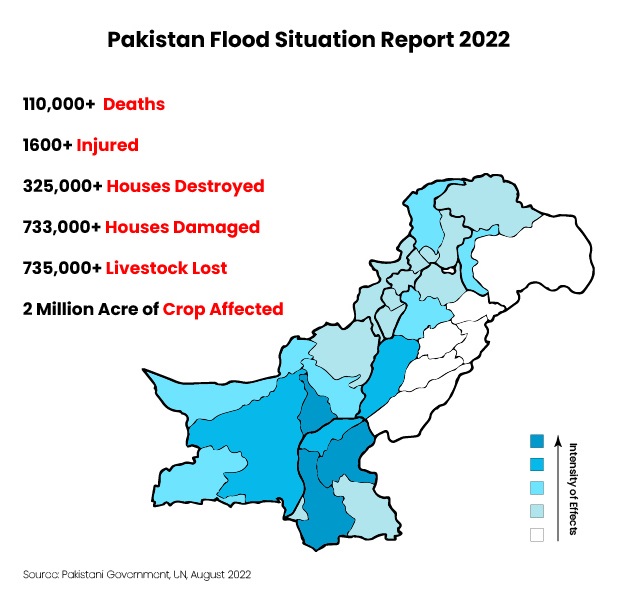
Follies of Human: A cause of flood
According to a World Weather Attribution investigation, the devastating floods were not primarily brought on by global warming; human-caused climate change likely played a role in the recent devastating floods in Pakistan. Flooding is frequently worsened by environmental degradation caused by human activities, which include
- Deforestation eliminates natural water-absorbing trees, raising flood and erosion risks during rainfall.
- Urbanization with impermeable surfaces prevents rainwater from seeping into soil, potentially causing floods.
- Climate change, fueled by greenhouse gases, leads to warmer temperatures and increased precipitation, contributing to flooding.
- Pollution exacerbates floods by clogging drainage systems and altering natural water flow.
- Flood embankments designed to hold water might hinder drainage during heavy rainfall.
- Infrastructure malfunctions, such as dam failures, can trigger flooding by releasing excessive water into local areas.
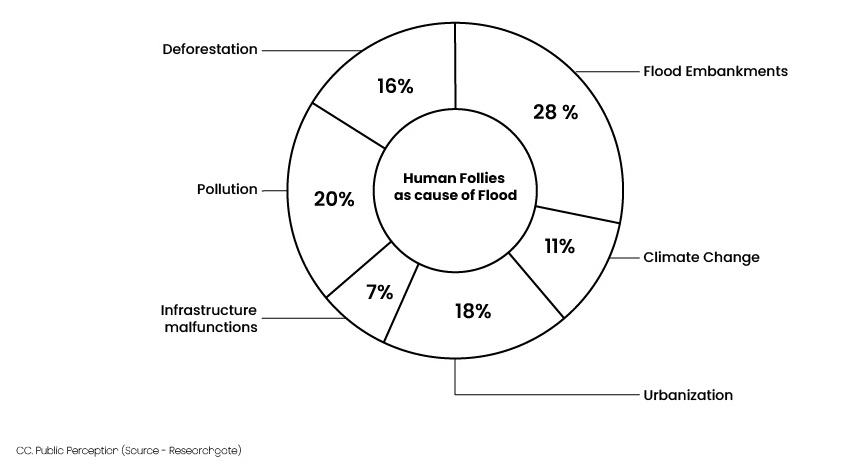
(B) State the message of ‘The Earth Hour Movement’.
Question Breakdown
In this question, the examiner has asked you to explain the Earth Hour movement. To solve this question, write down the definition and then write the paradigm associated with the need to start Earth Hour. Moreover, since Earth Hour happens every year, you can add a schematic Figure of the most recent Earth Hour to make your question appealing enough to stand among thousands of other aspirants.
Answer:
What is Earth Hour?
The Global Earth Hour is an effort initiated by the World Wide Fund. The yearly event, initiated on March 31, 2007, in Sydney, Australia, normally takes place on the final Saturday in March. It calls on people, groups, and organizations to switch off all electric lights for one hour between 8:30 and 9:30 p.m. as a show of support for the environment.
Message of Earth Hour movement
The goal of Earth Hour is to spread awareness of environmental issues in global and local communities. It inspires people, organisations, and governments around the globe to take responsibility for their ecological footprints, engage in resource sharing and debate, and take action to address pressing environmental issues.
“Every year, we countdown together across the globe to celebrate Earth Hour and take one iconic action: switch off the lights. But it is so much more than that. It is a symbol of unity. It is a symbol of hope. It is a demonstration of the power of collective action for our future and the planet’s.”
-World Wide Fund (WWF)
Question No. 3
(A) Porifera is an ancient group of animals from Cambrian Period. What is the cause of their survival/ success?
Question Breakdown
In this question, the examiner has asked you to explain the cause of the survival of ancient animal Porifera. Thus, to answer this question, First define Porifera with a few of its examples. Next, explain the history of Porifera, along with the reasons for their survival. Don’t write too much on characteristics and all that of Porifera because the question directly targets the longevity of the phylum. Thus, define and examples are enough before moving to the main argument.
Answer:
Define Porifera:
The name Porifera is derived from the Latin porus = pore, ferra = to bear. Thus, the Porifera are pore-bearing animals, commonly called the sponges. They are considered the most primitive phylum belonging to the Kingdom Animalia
Examples of Porifera:
- Sycon- A typical marine sponge
- Leucoselenia – A sponge consisting of a group of erect tubes
- Euplectella – A delicate sponge commonly called Venus lower basket
- Spongilla – A freshwater sponge
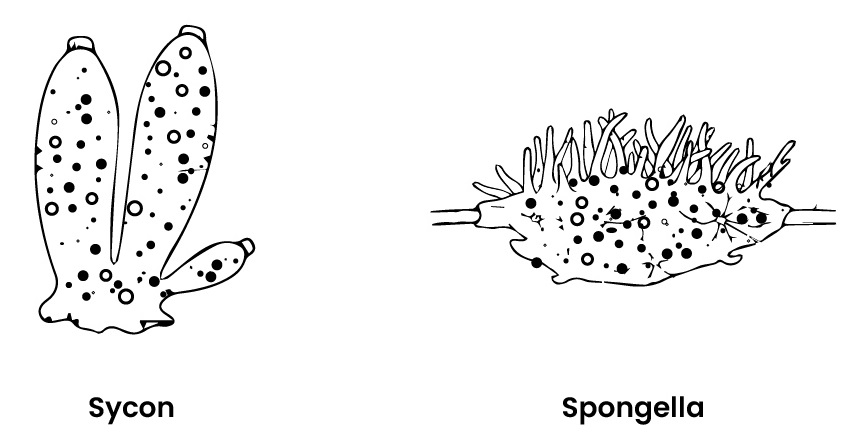
Causes of Survival of Porifera from the Cambrian Period to Now:
Historically, the Cambrian Period began around 485.4 million years ago and lasted 53.4 million years. The period is a significant period in the evolution of life on Earth since it saw the appearance of numerous invertebrate species, including Phylum Porifera. However, the Porifera did neither evolve much further nor destroyed or vanished due to the following reasons:
- Unique Aquiferous System:
Sponges possess a unique aquiferous system that serves as both a digestive system and a water circulation system. The water flow through the complex system oxygenates the sponge thoroughly, allowing oxygen to diffuse into the interior sponge cells.
- Deep Ocean Habitat:
All sponges are aquatic, inhabiting the Deep Ocean. Out of a total of 5,000 species, 150 species live in freshwater while all others are marine. Unlike shallower water marine life like corals, living well below the ocean’s surface shelters them from strong storms and temperature fluctuations.
- Totipotency:
Poriferans possess the ability of “totipotency,” enabling cells to transform both structurally and functionally, enhancing adaptability.
- Suspension Feeding:
Suspension feeding is another unique phenomenon exhibited by Porifera that filters nutrients from the water before ingesting food.
- Reproductive Adaptations:
Porifera employs both asexual and sexual reproduction strategies. This includes budding, gemmule formation, and fragmentation. Gemmules, unique to Porifera, are resilient structures that withstand adverse conditions and regenerate new sponges when conditions improve.
(B) How heavy water differs from ordinary water and what is its use in Atomic Reactor?
Question Breakdown
The question consists of two parts. In the first part, the examiner has asked about difference in ordinary and heavy water, and in the second part, you have to describe the role of heavy water in atomic reactor. Thus, to answer this question, simply draw a table of difference to answer the former with a diagram. And for the later part, directly move towards the reason. Remember rather than writing too much, focus on providing a pictorial representation of what you write to make your paper look appealing.
Answer:
| Characteristic | Ordinary Water | Heavy Waters |
| Definition | Normal water is the most abundant form of water, which is composed of dihydrogen oxide molecules | Heavy water is a form of water that contains deuterium oxide molecules (a heavier isotope of hydrogen) |
| Molar Mass | About 18g/mol | About 20g/mol |
| Chemical Formula | H2O | D2O |
| Uses | Essential for drinking, domestic cleaning, etc | Nuclear reactors, chemical and biochemical studies |
| pH | pH of 7 | pH of 7.41 |
| Freezing Point | Freezes at 0°C | Freezes at 3.82°C |
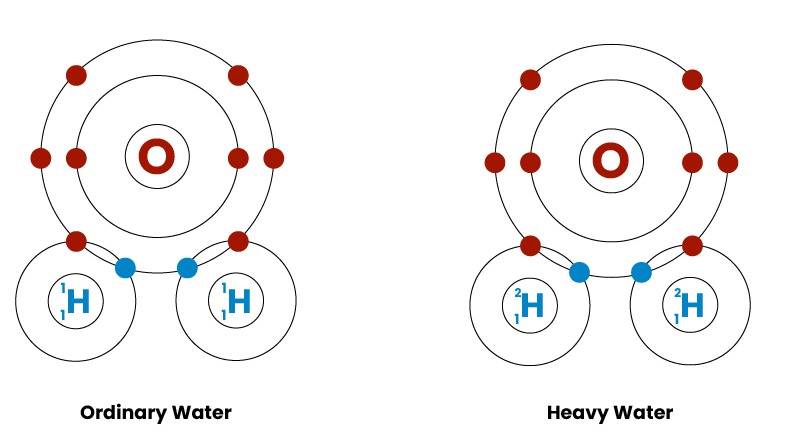
The Use of Heavy Water in Atomic Reactor:
Since the Atomic reactor works on the phenomenon that works on the principle of fission reaction – a highly uncontrolled reaction, heavy water in nuclear reactors acts as a neutron moderator to slow down neutrons. Specifically, heavy water is used for the action because Deuterium works more efficiently as a moderator, absorbing fewer neutrons than hydrogen. Moreover, heavy water is more likely to react with the fissile uranium-235 than with uranium-238, which captures neutrons without fissoning, thus, managing the chain reactions.
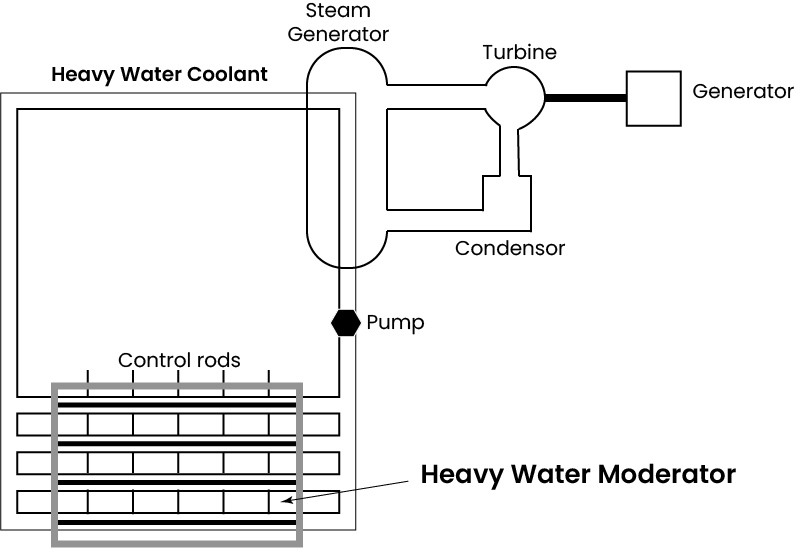

Question No. 4
What part do antibodies play in allergic reaction? How vaccination can be helpful in its control/ prevention?
Question Breakdown
In this question, the examiner has asked to state the role of antibodies in allergic reactions in the first part and the role of Vaccination in the prevention of allergies. Before answering the question, you must know it contains ten marks. So, you have to answer each part considering five marks length and data. In order to answer this question, first define antibodies, naming important antibodies. Then, explain the whole process of the role of antibodies in causing allergy with a diagram. After that, move to the next part, keeping your question coherent by linking the role of vaccination in controlling the reaction. Draw a diagram here too, if possible.
Answer:
Define Antibodies:
An antibody, also known as an immunoglobulin, is a large Y-shaped protein used by the immune system to identify and neutralize foreign objects, such as pathogenic bacteria and viruses, called antigens. When antibodies find their target, they bind to it, thus destroying the attackers.
Role of Antibodies in Allergic Reaction:
As mentioned above, antibodies yearns to recognize and destroy foreign substance, which it found harmful for body. The following steps take place when pollens, dust, mould, or other immune-sensitive foreign substances enter the system.
- Antigen Recognition
On the invasion of any harmless foreign body or allergen, the particular immune system – not the immune system of all becomes alert, recognizing that body as a potential threat.
- Antibody Production:
The immune system, in response to the allergens, produces specific antibodies. Allergic reactions, predominantly, are associated with immunoglobin IgE
- Antibody-Antigen Binding:
Antibodies have a unique structure that enables them to specifically recognize and bind to antigens that are perceived as harmful, creating IgE-allergen complexes.
- Immune Cell Activation:
The IgE- allergen complex is transported to immune cells called mast cells and basophils, thus, activating the reaction process.
- Chemical Release:
This binding triggers mast cells and basophils to release chemicals, including histamines, which cause various allergic symptoms like inflammation, itching, runny nose, wheezing, scratching, watery eyes, and respiratory distress.

Role of Vaccines for the Prevention of Allergic Reaction
Vaccines- a substance typically prepared from an inactivated or weakened causative agent- not only aim to strengthen immune responses but are also effective for the treatment of allergies. Such vaccination with allergens is called allergen-specific immunotherapy, commonly known as allergy shots. Being introduced in 1911 by L. Noon who published the first successful immunotherapy trial in grass pollen-allergic patients using pollen extracts administered by subcutaneous immunization, allergy shots function in a manner similar to vaccines. In simple terms, allergy shots contain weakened or dead allergen agents or some relevant chemical. When the shot is injected, the agents activate the immune system the same as the allergens do, but not enough to show symptoms. In this way, the antibodies get immune to the coming antigens. After that, even when the original allergen comes in contact, the body’s immune system takes it as a normal substance rather than a potential threat, thus protecting it from allergic reactions. Other than allergy shots, tablets or drops can also be used for this purpose.

Question No. 5
(A) Differentiate between renewable and nonrenewable sources of energy. Give examples of each one of them.
Question Breakdown
This question requires differentiation of renewable and nonrenewable sources of energy. To answer this question, draw a table of differentiation with either two or three columns, with one column explaining the characteristics’ names or the other two columns with the differences corresponding to the terminologies. In the end, draw a basic schematic diagram clarifying examples for each one of them.
Answer:
| Characteristics | Renewable Energy | Non- Renewable Energy |
| Definition | The sources of energy which on usage can’t be lost forever, but can be recycled and replenished | The sources of energy which on usage are lost forever, and can’t be recycled and replenished |
| Biodegradability | Renewable energy sources are eco-friendly and do not cause much pollution in the atmosphere | Non-renewable energy sources are not eco-friendly and cause a lot of pollution in the atmosphere due to the emission of excessive carbon |
| Recycling and Reusability | These energy sources can easily be reused and recycled | One cannot reuse and recycle these types of energy resources |
| Sustainability | These resources are sustainable | These energy resources are not sustainable instead exhaustible |
| Storage and Installation Cost | The overall cost of these energy sources is high. It required high capital to install and maintain these sources of energy | The overall cost of these energy sources is not very high because they can be found naturally |
| Examples | The five major sources of renewable energy are; solar, wind, hydro, geothermal, and biomass | The non-renewable resources are; coal, nuclear elements, oil, natural gas, and fossil fuel |
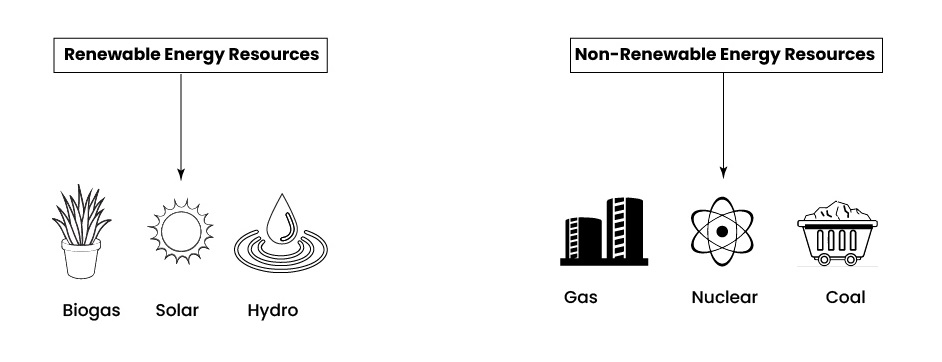
(B) Why nuclear energy is being preferred in developed countries and why are we lagging behind in this important source of energy?
Question Breakdown
In this part, you are being asked to define and explain nuclear energy with special reference to its reaping benefits in developed countries and the reasons for the lag in its use in developing countries. So, first define Nuclear energy, then, in general global benefits of nuclear energy with any case study. In the end, explain the reasons for the undermined use of nuclear energy in Pakistan. Although the question asked in this particular exam is for 2.5 marks, here it is solved as 5 marks question so that it can be helpful for aspirants in the future.
Answer:
Define Nuclear Energy:
The energy in the nucleus, or core, of an atom is called nuclear energy in simple terms.
An Overview of Nuclear Energy Production:
Technically, nuclear energy is energy that is released from the splitting of the nucleus of an atom through a process called nuclear fission. The energy released in the form of heat is then used to produce steam from water, driving turbines connected to generators. The rotating turbines generate electricity, making nuclear power a low-carbon, high-energy-density source of electricity.
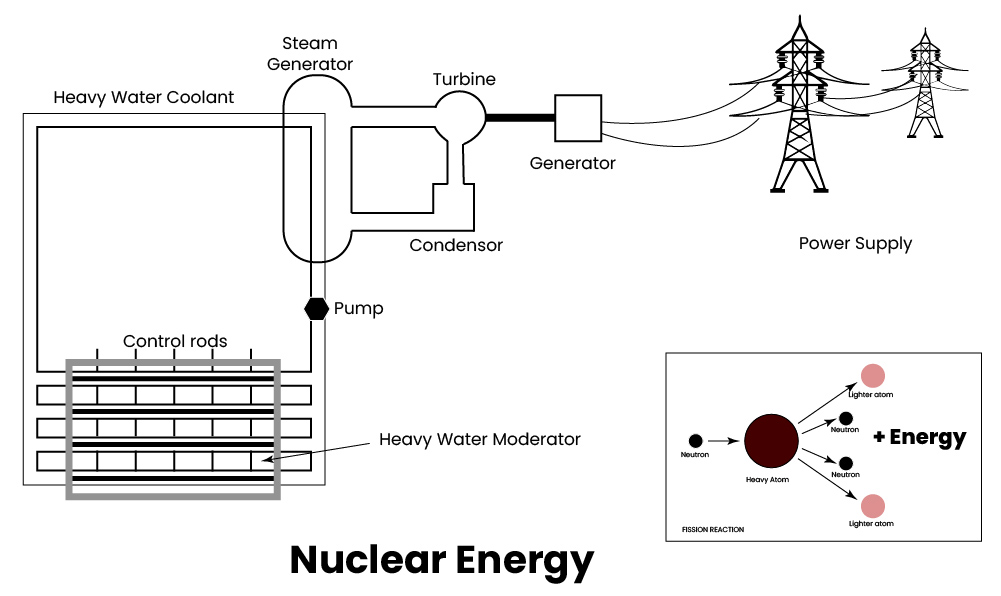
Nuclear Share of Global Energy Mix:

Reasons behind the Preferability of Nuclear Energy Worldwide:
Nuclear Energy is preferred worldwide due to the following reasons.
- Nuclear energy protects air quality by producing massive amounts of carbon-free electricity as it does not produce harmful by-products.
- No greenhouse gase emissions from nuclear energy, so helpful in countering global warming.
- Nuclear energy generates substantial carbon-free power on minimal land, vastly surpassing wind and solar requirements, needing over 360 times less land than wind and 75 times less space than solar for comparable electricity output.
- It fuels local economies in 28 US states and supports a variety of non-electric uses, from the medical industry to space exploration.
Lagging of Pakistan in Usage of Nuclear Energy:
Despite the countless benefits of Nuclear Energy, developing countries like Pakistan are still lagging in its usage due to the following reasons
- Pakistan lacks the required technology and skilled manpower to sustain nuclear power plant operations.
- Challenging political barriers like lack of political will, bad governance, and political instability hinder large-scale nuclear power pursuit.
- International reluctance from the US, France, and the UK for nuclear cooperation has made Pakistan lag in the field.
- Economic Hurdles, like high costs and lengthy construction times of nuclear reactors, deter the nuclear industry in the country.
- Pakistan’s nuclear program is also hindered by its non-signatory status to the Nuclear Non-Proliferation Treaty due to its weapons program.
Thus, it is high time Pakistan focused on building technology capabilities, fostering political support, engaging diplomatically, strategizing economically, and reevaluating international commitments to advance its nuclear energy adoption.
Question No. 6
(A) What is nanotechnology and what are its uses.
Question Breakdown
In this question, the examiner has asked you to explain nanotechnology and their uses. Thus, in order to answer this question, you have to define nanotechnology, giving a brief weightage to its history. Then, move to its usage in five main points. Draw a key or diagram if possible.
Answer:
Define Nanotechnology:
A structure, device, or system that is created, produced, or used by manipulating atoms and molecules at the nanoscale or having one or more dimensions of the order of 100 nanometers (100 millionth of a millimetre) or less is referred to as nanotechnology or simply nanotech.
Invention of Nanotechnology
Richard Feynman explained nanotechnology long ago; however, the official term of nanotechnology was coined on December 29, 1959.
Uses of Nanotechnology
Nanotechnology is widely used in many fields, some of which are mentioned below
- In Agriculture:
Nanotechnology is utilised to improve plant growth and disease resistance, as well as to create novel agricultural breeding techniques. Food fortification techniques that can more effectively and precisely distribute vital nutrients to food items have been developed using nanotechnology.
- In Healthcare:
Nanotechnology is widely used in the field of medicine as nanomedicine. There may be uses for certain nanoparticles in cutting-edge diagnostic tools, imaging and methodology, pharmaceutical items, biomedical implants, and tissue engineering.
- In Consumer Products:
Nanotechnology is present in everyday products. For example, nanoparticles of silver are used to deliver antimicrobial properties in bandages and socks. Zinc or titanium nanoparticles are the active UV-protective elements in modern sunscreen. Moreover, scratch-resistant eyewear, anti-graffiti coatings for walls, crack-resistant paint, stain-repellent textiles, and ceramic coatings for solar cells are all products made with nanoparticles today.
- In information and Communication
Nanotechnology is used in information and communication by introducing smaller and more efficient electronic components. It plays a pivotal role in crafting nano-scale materials that manipulate light, enhancing data transfer rates in fiber-optic communication. Moreover, nanotechnology’s potential in quantum computing is revolutionizing data processing capabilities.
- In Environment:
Nanotechnology improves water quality through advanced filtration using nanoparticles and enhances air quality by integrating nanomaterials into air filters for efficient removal of pollutants and particulates.
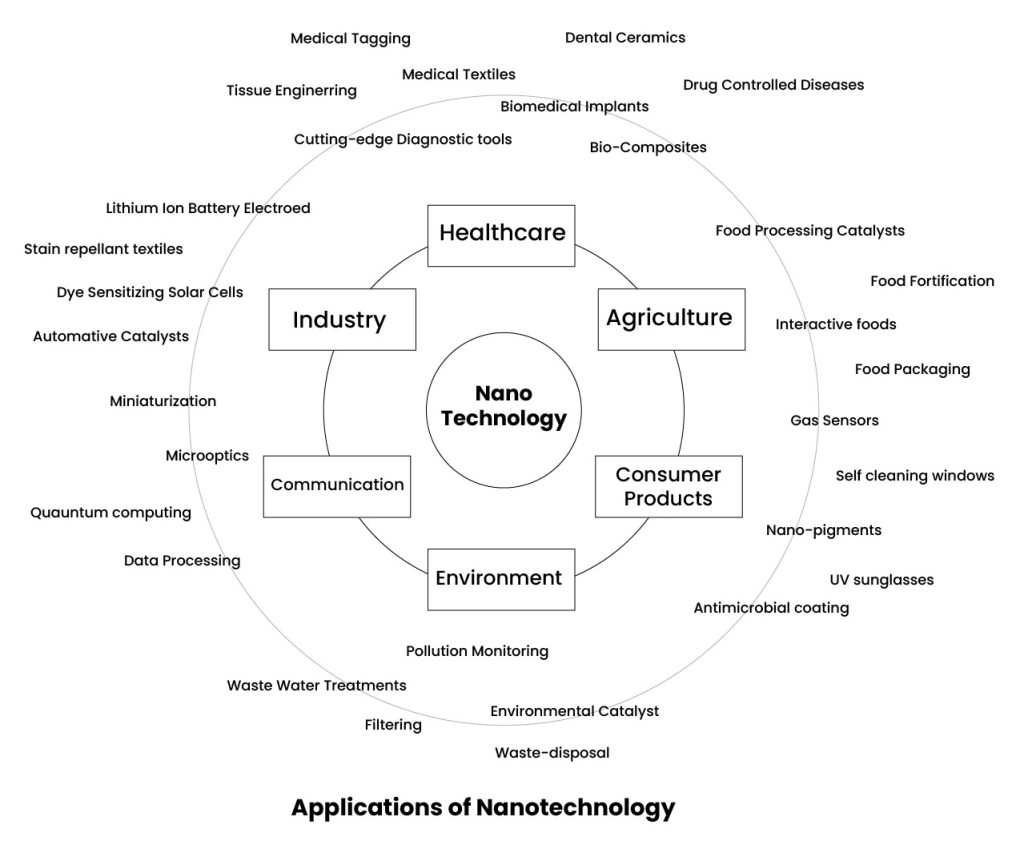
(B) Briefly explain differences between chemotherapy and Radiotherapy
Question Breakdown
In order to fully answer this question, you need to differentiate between chemotherapy and radiotherapy. For doing so, define chemotherapy and radiotherapy, write their uses and application as well.
Answer:
| Characteristics | Radiotherapy | Chemotherapy |
| Definition | Use of high-energy X-rays or particles to destroy cancer cells | Use of powerful chemical drugs to kill fast-growing cancer cells |
| Treatment Method | Uses ionizing energy, such as X-rays or protons, targeted at the tumour. | Involves systemic administration of cytotoxic drugs. |
| Cell Targeting | Targets a specific tumor or region | Affects cells throughout the body |
| Delivery Methods | External radiation via machine. | IV process using a needle or tube. |
| Side-effects | Fatigue, skin conditions, stiffness, swelling, digestive issues, etc. | Fatigue, hair loss, anaemia, weakness, nausea, vomiting, etc. |
| Implications | Can have effects beyond the primary tumour area but not always | Impacts cells throughout the body |
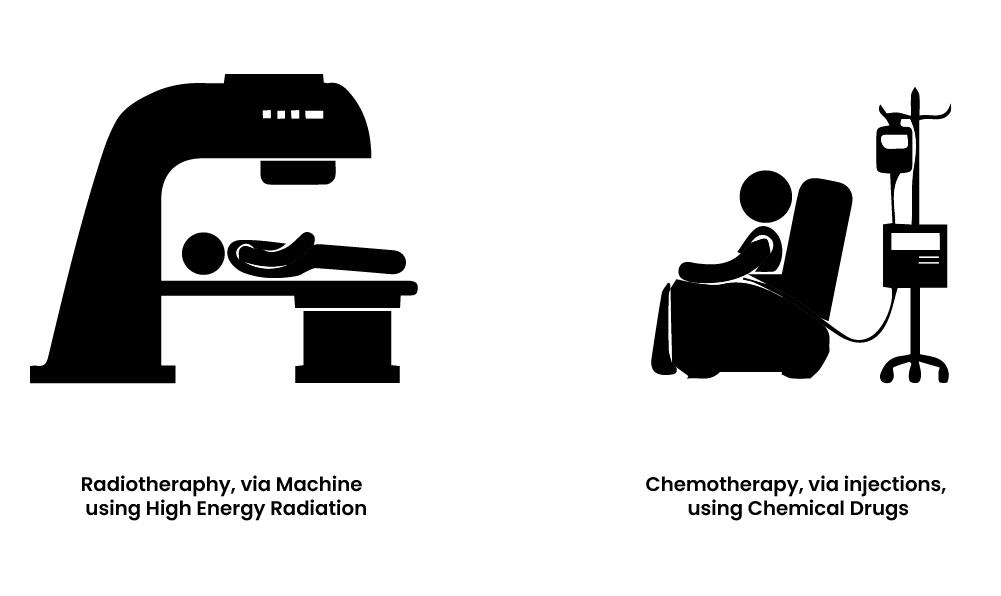
Question No. 7
Write a comprehensive note on
(A) LASER and their uses
(B) OPTIC fibres and their importance in modern telecom system
Question Breakdown
In both parts of this question, the examiner has asked you to write notes on the given terminology. The first part demands that you elaborate on LASER and its uses. Thus, to write a detailed note, you need to define LASER first. Further, write down how laser works and its uses as well. Likewise, in the second part, write a detailed note on Fibre Optics through definition, working principle, and uses in modern telecom systems. Remember, do not forget to draw diagrams of both. Here, each part is solved separately as 5 marks question.
Answer:
- (I) LASER
Define LASER:
The full form of LASER is “Light Amplification by Stimulated Emission of Radiation.” It is a device that stimulates atoms to emit light at optical wavelengths and amplifies that light to produce a highly monochromatic, coherent beam of radiation.
Working principle
When the energy from a light source or an electrical current is absorbed by the electrons in the atoms of optical materials like glass, crystal, or gas, the electron from an atom excites from the ground state to the excited state, that is, from the orbital of low energy to high energy after absorption. The absorbed energy is then emitted at a very particular wavelength during the de-excitation of electrons. The wavelength with which light is emitted is coherent LASER that is based on the target material.
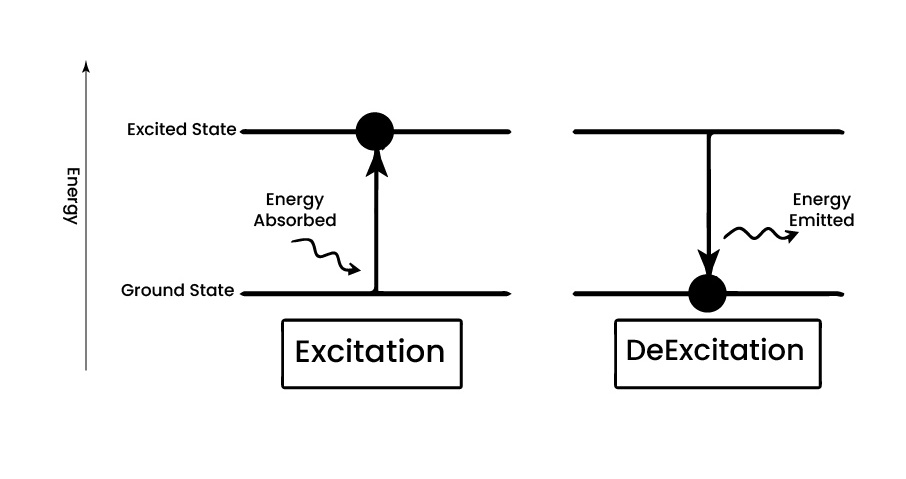
Uses of LASER:
The utilization of lasers spans various domains, each with distinct applications.
- In Medicine:
In the field of medicine, highly chromatic laser beams are used to destroy kidney stones, perform bloodless surgery, and diagnose and treat cancerous cells. Moreover, the device is used for eye lens curvature corrections for cosmetic treatments such as acne therapy, cellulite and hair removal. Lasers are also used in fibre-optic endoscopes to detect ulcers in the intestines, create plasma, and remove the caries or decayed portion of the teeth.
- In Communications:
Laser light is used in optical fiber communication systems to transmit information at very large distances with minimal loss. Further, they are used in underwater communication networks, space communication, radars and satellites.
- In Industries:
In industries, lasers are used to cut quartz and glass, detect holes or leakages in large ships and treat them. They are also used in electronic industries for trimming the components of Integrated Circuits (ICs). Not only this, lasers are used in the semiconductor industries for photolithography- a method used for manufacturing microprocessors and circuit boards.
- In Science and Technology:
The use of a helium-neon laser established the fact that the velocity of light is the same in all directions. Moreover, lasers are used to detect Brownian motion and count the number of atoms in a substance. Lasers in computers help to retrieve stored information from a Compact Disc (CD) and store large amounts of information or data in CD-ROM. Lasers are used to produce 3D pictures in space without a lens.
- In Environment and Disaster Detection:
Lasers, in the realm of the environment, are used to measure the pollutants and other contaminant gases in the atmosphere. Moreover, they are used for detecting earthquakes and underwater nuclear blasts. A gallium arsenide diode laser is used to set up an invisible fence to protect an area.
- Lasers in Military:
Lasers are used to measure the distance to an object accurately in LIDAR’s. The ring laser gyroscope is used for sensing and measuring very small angles of rotation of moving objects. Moreover, by damaging a missile, the laser is used to dispose of the energy of a warhead.
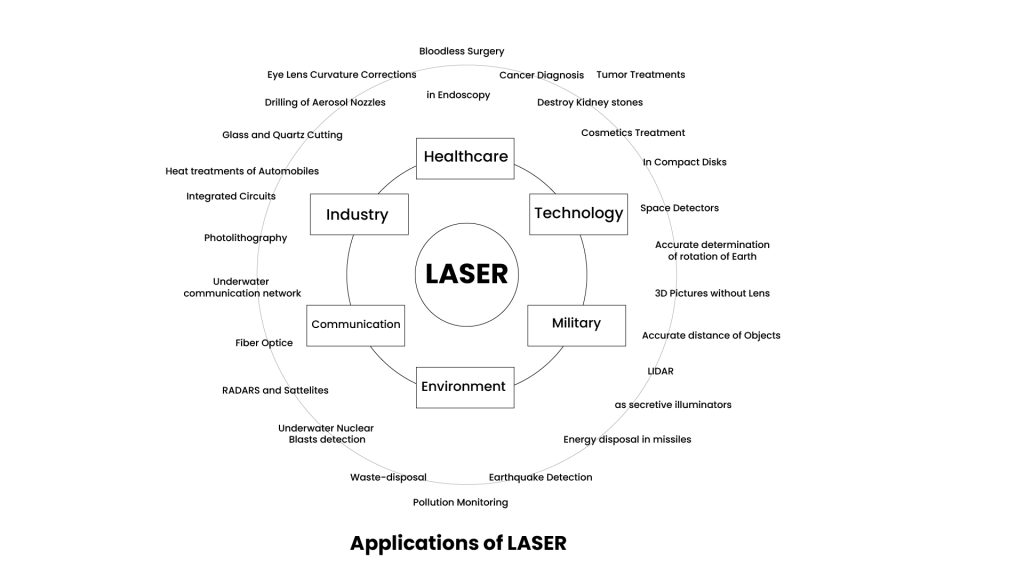
- (II) Optical Fiber:
Define Optical Fiber:
Fibre optics is a bundle of thin strands made of glass or plastic, which uses light (photon particles) to transmit signals. Therefore, the transmission capacity of fibre optics is far greater than other modes of communication, such as copper wire and metallic wires. As a result, it is used in the form of different cables and is being utilized in numerous fields of life.
Working of Optical Fiber:
In a fibre-optic system, a machine called a transmitter turns information into the light. Then, the transmitter sends the light through optical fibres. As the light moves at a high speed through the core, it bounces off the cladding either by the phenomenon of total internal reflection or continuous refraction. If the fibre has a bend in it, the light can bounce off the cladding and turn the corner to follow the bend. At the end of the fibres, a machine called a receiver accepts the light. The receiver turns the light back into sound, pictures, or computer codes.
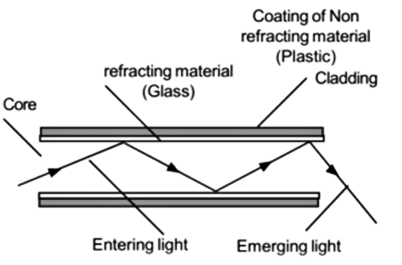
Importance of Optical Fibre in Telecommunication
In modern telecommunication, optical fibre has far-ranging applications in delivering cable television signals, internet communications, and telephone signals due to certain characteristics
- High Bandwidth and Data Transmission:
Optical fibres are used as a medium for telecommunication and networking due to their ability to provide a much higher bandwidth that allows for the efficient delivery of large amounts of data.
- Advantageous for Long-Distance Communications:
In the optical fibre, light propagates through the fibre with minimal attenuation, unlike electrical copper cables, which suffer from significant signal loss over distance, which helps it transmit that huge chunk of data to comparatively longer distances.
- Low Signal Attenuation:
Likewise, light signals transmitted through optical fibres experience minimal attenuation, ensuring that data can be transmitted over long distances without significant loss of signal strength.
- Lightweight and Efficient Design:
Light and unique flex fibre optic cables not only aid in efficient transmission but also make installation and maintenance easier and more cost-effective.
- Immunity to Interference:
Last but not least, Fiber optics do not suffer from the stray interference pickup that helps maintain signal quality and integrity, leading to reliable communication.
Question No. 8
Write all that you know about pesticides. How are they classified by agronomists?
Question Breakdown
In this question, the examiner has asked you to explain pesticides with their classifications. The question may seem simple, but before answering it, keep in mind it contains ten marks; hence, among the two parts of the question: understanding and classification, each contains five marks. Thus, first, write a comprehensive note on pesticides, which involves definitions, examples, and usage. Then move on to their classification according to agronomists with a proper pictorial representation. Remember, do not forget to add as many relevant diagrams as you can to meet the requirements of your GSA Paper, “Candidates should elaborate their answers using graph/diagram/table where required.”
Answer:
Define Pesticides:
Pest: Harmful organism; Cide: To control
The substances that are used for preventing, controlling, or destroying pests, unwanted species of micro or macro-organisms, herbs or any vectors of human or animal disease causing harm when intervene in the production, packaging, transport, or consumption of food are called pesticides.
Global Use of Pesticides:
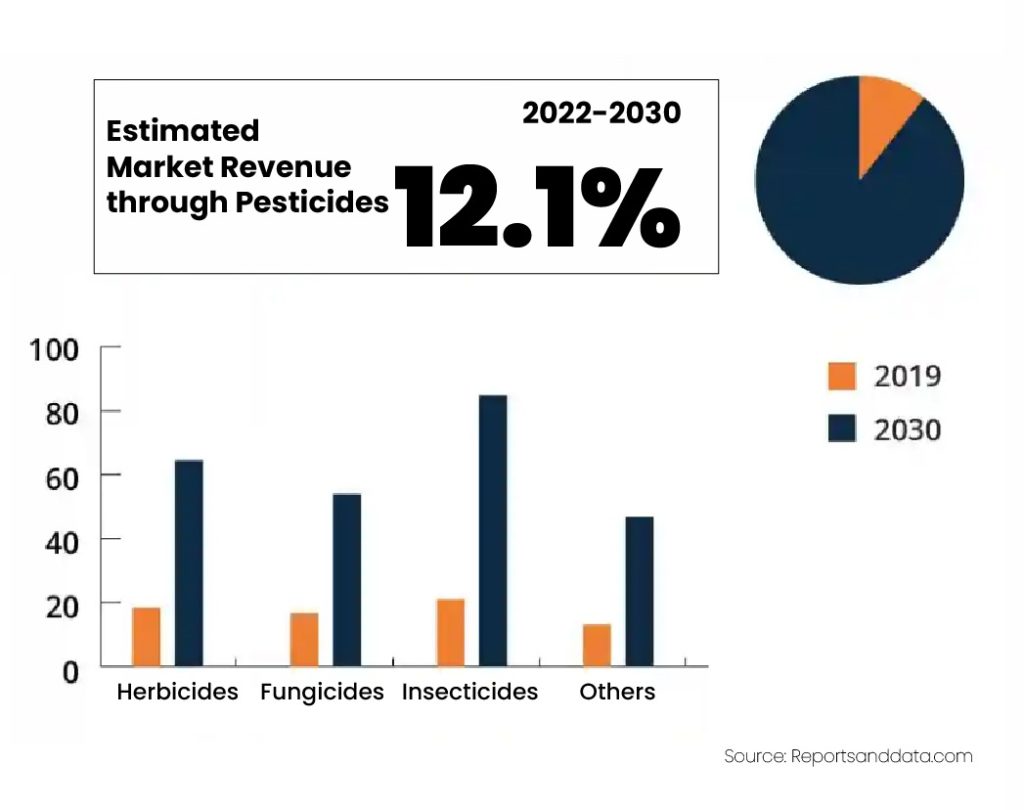
Advantages and Disadvantages of Pesticides:
| Advantages | Disadvantages |
| Enhanced Crops Productivity | Threat to Environment |
| Cheap and Easily Available Food | Not Permanent |
| Prevention from Hazardous Organisms | Cause of Human Diseases |
| Positively Impacts Economy | Declines Soil Fertility |
Agronomic classification of pesticides
Although there are multiple types of pesticides, but not all classifications are introduced by the agronomists. Since agronomists deal with ways to improve the quality and quantity of crops, they have only given the classification impacting quality and quantity by killing unwanted organisms. The types are as follows

- Herbicides:
Herbicides are the form of pesticides that eliminate or manage grasses and other undesirable plants. They are frequently applied to fields.
- Insecticides:
Insecticides are made on the principle of eliminating or regulating insects. They are utilized in homes, companies, industries, and agriculture.
- Fungicides:
Fungicides can be applied to plants or other areas where mould or mildew grows to suppress fungi. They might also help to keep produce safe.
- Bactericides:
Bactericides are bacteria targeting pesticides. They are generally disinfectants, antibiotics, and antiseptics. They are not only used in crops but also in everyday life to kill bacteria from surfaces.
- Rodenticides:
Rodenticides aim at rodent populations- mice, rats, squirrels- to reduce the chances of exposure to diseases and to mitigate the already caused damage to crops.
- Larvicides:
Larvicides are the insecticides used to control insects’ larvae around homes and crops before they grow into adults. According to experimentation, larvicides are effective enough to kill 99% of larvae before they can cause harm.
Question No. 9
Write note on
(A) Biotechnology
(B) Global Warming
Question Breakdown
In this question, the examiner has asked to write a note on Biotechnology. To write a note on biotechnology, you need to define biotechnology. Write down the various applications of biotechnology. Give the scope of studying or working in this field to fully answer this question. In this question, the examiner is required to write a detailed note on Global warming. To do so, define global warming. Further, write down the causes and effects of global warming.
Answer:
- (I) Biotechnology:
Define Biotechnology:
Biotechnology is the use of living beings or processes to form different products essential for living beings. It is an emerging discipline that has left behind all technical evolved processes by utilizing both cellular and biomolecular processes to produce products and processes that improve human lives in particular and the planet’s biological system in general.
Examples of Biotechnology:
- In beer brewing and bread baking, yeast is found to be the by-product of fermentation- a biotechnological process.
- Penicillin is an antibiotic that is generated by certain moulds (fungi), thus utilizing a living being for human use, i.e., to treat bacterial infections.
- In gene therapy, genetic disorders of humans are treated by creating a copy of a particular gene through living organisms.
Types and Applications of Biotechnology:
Biotechnology is divided into the following types:
- Medical Biotechnology:
Medical biotechnology al, so-called Red Biotechnology, deal with the use of living cells to establish technologies for the improvement of human health. For example, vaccines, antibiotics, insulin, and gene therapy.
- Industrial Biotechnology:
Industrial Biotechnology is called White Biotechnology and involves the production of alcohol, cosmetic products, detergents, etc., for global consumption. Moreover, the genes from the spiders are picked up through biotechnological techniques and infused in goats to produce silk proteins in their skin.
- Agricultural Biotechnology
This field, also called Green Biotechnology, deals with the development of genetically modified plants by introducing the gene of interest in the plant. This, in turn, helps in increasing the crop yield. Various pest-resistant crops such as Bt-cotton and Bt-brinjal are created by transferring the genes from Bacillus Thuringiensis into the plants. It is used to break pollutants in air, water, and soil through the use of bacteria, algae, and fungi.
- Food Biotechnology
Food Biotechnology, also called Yellow Biotechnology, deals with enhancing the taste, yield, shell life and nutritive values of food.
- Marine Biotechnology:
In marine biotechnology, which is also called Blue Biotechnology, the ocean living beings are explored to develop innovative pharmaceutical drugs, enzymes, chemical products, and other industrial products and processes.

Future of Biotechnology
Biotechnology is a rapidly advancing field, with new breakthroughs and innovations emerging every year. Some of the current areas of research in biotechnology include gene editing, synthetic biology, and personalized medicine. As the field continues to grow and evolve, it is likely that biotechnology will continue to have a significant impact on many areas of our lives.
- (II) Global Warming:
Define global Warming:
The gradual increase in the average temperature on the Earth is known as global warming, mainly as a result of the greenhouse effect. The greenhouse gases act like insulation to keep the Earth warm. However, as more greenhouse gases get into the atmosphere, the Earth will start to grow warmer. The main greenhouse gases are water vapours, carbon dioxide, and methane.
Causes of Global Warming:
Global warming is an alarming situation caused by several activities on the Earth, like deforestation, waste disposal, overconsumption, mining, fossil fuel burning, and intensive farming.
- Deforestation:
Cutting down forests reduces the planet’s capacity to absorb carbon dioxide (CO2), contributing to warming.
- Waste Disposal:
Improper waste disposal, such as landfill decomposition, releases methane (CH4) and CO2, exacerbating greenhouse gases into the atmosphere.
- Over Consumption:
Excessive consumption of goods requires more energy for production, increasing greenhouse gas emissions from manufacturing.
- Fossil Fuel Burning:
Excessive burning of fossil fuels, including coal and natural gas, releases a lot of CO2, CO, and other such gases, which trap in the atmosphere and cause global warming.
Impacts of Global Warming:
The major impacts of global warming are as follows
- Melting of Glaciers:
Many glaciers are already melting and shrinking throughout the world due to increased temperatures.
- Rising Sea Levels:
As the glaciers melt, the ocean levels will rise. This could cause flooding in cities located near coastal areas.
- Disrupting Food Chain:
Animals will migrate to cooler spots as their old habitats get too warm. This could upset the food chain and put some species in danger of extinction.
- Increasing Natural Disasters:
Global warming will cause more powerful hurricanes, famines, droughts and flooding in different areas of the world.
Ways to Prevent Global Warming:
Although global warming has reached the point where collaborative efforts are the need of the hour, the following measures can contribute in the prevention of global warming.
- Plant more trees to enhance carbon sequestration and improve air quality.
- Install waste processing plants to manage and reduce pollution from waste disposal.
- Switch to alternative energy sources to decrease reliance on fossil fuels.
- Introduce sustainable transportation options to reduce emissions and congestion.
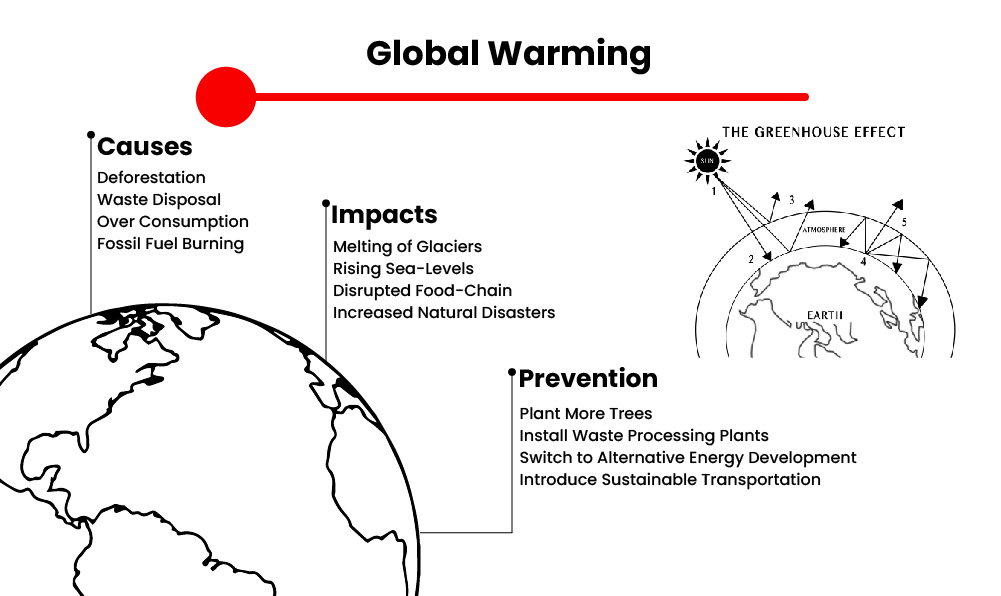
CSS Solved Past Papers’ Essays
Looking for the last ten years of CSS and PMS Solved Essays and want to know how Sir Kazim’s students write and score the highest marks in the essays’ papers? Then, click on the CSS Solved Essays to start reading them.
CSS Solved Essays













